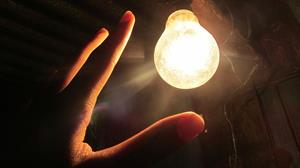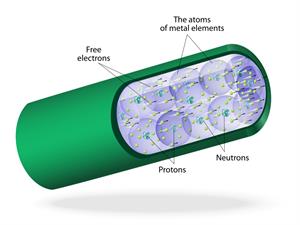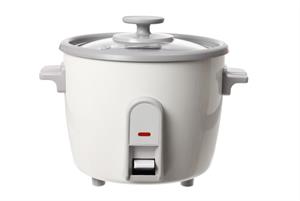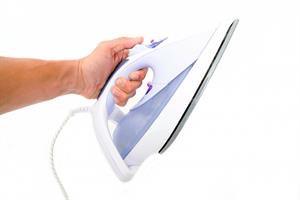PDF chapter test TRY NOW
Important!
One should never experiment with the power supply or electric circuits without adult supervision. Carelessness while handling an electric circuit may create an accident and could be dangerous.
Generally, we use electric bulbs in our houses for lighting. Try to touch a light bulb when it is switched off. Do you feel anything?
Now, turn on the light and wait for a few minutes. Then, take your hand near the bulb and touch it again. What do you sense?

Heat radiation from the bulb
You can feel some warmth in your hand.
The bulb does not glow when the switch is kept in the 'OFF' state, and hence no heat is produced. When the switch is turned 'ON', the bulb glows. After a minute of glowing, some amount of heat is felt when the bulb is touched. This warmness is due to the heating effect of electric current.
Due to the continuous flow of electric supply, the bulb becomes very hot. That is why one should never touch an electric bulb when it is lighted.A potential difference is developed across a resistor due to the internal chemical reactions of an electrical energy source. This potential difference makes the free electrons in the conductor to flow from the end of lower potential to a higher potential. Thus, the motion of free electrons, constitutes the current through the resistor. The electrical source or the cell continuously spends its chemical energy to pull the current constantly.
The explanation for heating:

Movement of free electrons
During this process, the free electrons continuously collide with the positive ions of the conductor. The positive ions thus gain some energy and vibrate vigorously. Only a part of the energy from the source is used for work, while the rest is converted into heat. As a result of the passage of electric current across a conductor, heat is produced. This phenomenon is known as the Heating effect of current.
Experiment on heating effect:
Important!
Please note that one must use only 9V\ dc battery for the heating effects investigations. Students should avoid using the main residential electric supply, which is 220V\ ac voltage, at all costs. If used, it will cause a powerful electric shock to our bodies, causing serious injury.
This experiment requires:
- An aluminium foil,
- A wooden board,
- A 9V\ dc battery, and
- Two connecting wires

Experimental setup
Procedure:
- Cut an aluminium foil in the shape of an arrow.
- Make sure that the head of the arrow is pointed.
- Now, place the arrow-shaped foil on a wooden board.
- Connect a thin pin to two wires of a certain length.
- Connect the wires to the terminals of the 9V electric cell.
- Keep one pin onto the pointed tip of the arrow and another pin (about 1 or 2\ mm) away.
Observation:
When the pin is kept at the tip of the arrow, the aluminium foil starts melting. This melting of the foil shows the heating effect of the current.
When the pin is kept at the tip of the arrow, the aluminium foil starts melting. This melting of the foil shows the heating effect of the current.
Heating effect in appliances:
Many household electrical appliances use this heating effect to make our work easier.

Electric cooker

Electric iron
